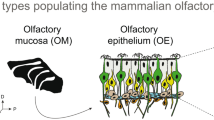Abstract.
Olfactory transduction begins with the binding of an odorous molecule to a protein receptor—odorant receptor—on the cell surface of olfactory neuron. Odorant receptors are encoded by a large gene family belonging to the superfamily of G-protein-coupled, seven-transmembrane-domain receptors. Since the identification of the receptor gene family in 1991, a considerable amount of progress has been made in the study of odorant receptors, including aspects of spatial and temporal expression pattern, the genomic organization of the receptor genes, regulation of expression, and receptor function. These studies are of critical importance in understanding how the olfactory system recognizes and distinguishes thousands of odors.
Similar content being viewed by others
Author information
Authors and Affiliations
Additional information
Received 16 June 1999; received after revision 13 September 1999; accepted 13 September 1999
Rights and permissions
About this article
Cite this article
Zhao, H., Firestein, S. Vertebrate odorant receptors. CMLS, Cell. Mol. Life Sci. 56, 647–659 (1999). https://doi.org/10.1007/s000180050459
Issue Date:
DOI: https://doi.org/10.1007/s000180050459




